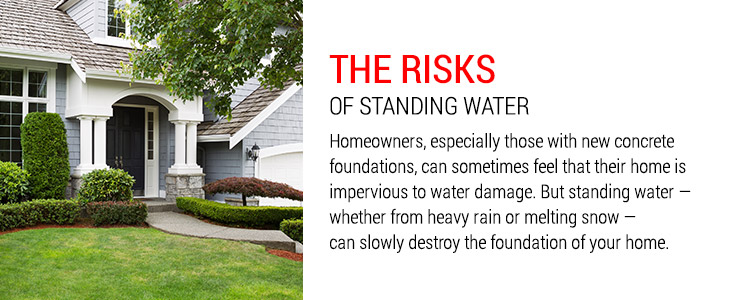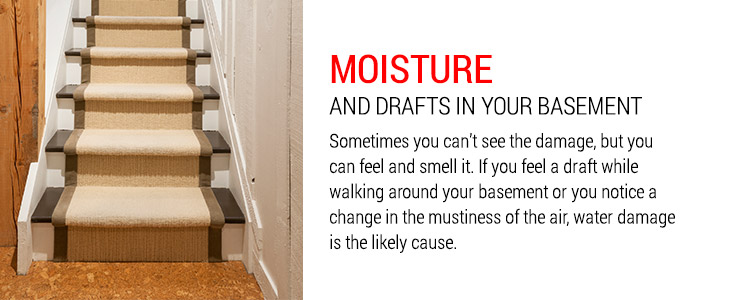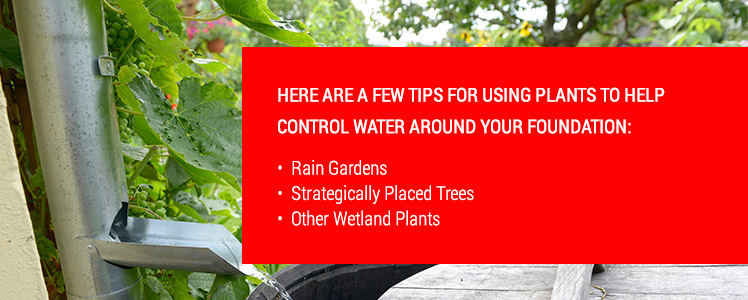
Using landscaping to prepare your foundation for winter
With the coming of winter, many homeowners become concerned about the potential for home foundation water damage. Heavy rains and snow melt can put a lot of pressure on the natural drainage of your landscape. And if water doesn’t drain properly, it can collect around your foundation to cause serious and expensive problems, including cracked and sinking foundations.
Thankfully, there are a number of landscape solutions for stormwater and snow melt that will help prevent water damage while also creating a beautiful outdoor space for you and your family. Dry wells and catch basins collect pooled water and redistribute it while swales and French drains redirect water away from your foundation. Once you examine your drainage needs and your personal landscaping tastes, you’ll be sure to find a beautiful and practical landscaping solution perfectly suited to you.
So as you prepare for the coming of winter, let’s take some time and discuss the best home yard drainage options offered by all of us at Colonial Excavating.
The Risks of Standing Water

Homeowners, especially those with new concrete foundations, can sometimes feel that their home is impervious to water damage. But standing water — whether from heavy rain or melting snow — can slowly destroy the foundation of your home.
Concrete may seem like a strong, impervious material, but it’s not. Since it is porous, water can easily find its way into your concrete foundation. In time, that water will begin to break down the concrete, causing it to crack. A cracked foundation is a dangerous and expensive problem to fix.
But standing water can also begin to erode the soil around your foundation, which can be equally dangerous. If the soil beneath the foundation begins to soften, your home can literally sink, causing incredible structural damage.
Water Damage Warning Signs
Before we spell out some of your options for water drainage solutions, we think it’s best to offer some of the signs of a foundation suffering from water damage. Any damage to your foundation must be addressed immediately, but you can also transform your landscape to help prevent any foundational damage in the future.
Here are some issues to watch out for during the winter months:
-
- Cracked and Leaky Basements — The clearest sign of foundational damage is a visible crack. If you see a crack in your basement wall or notice rainwater coming into your basement, you must address these concerns immediately. A cracked foundation can cause your home to shift and, in the worst-case scenario, even collapse. As heavy snow melts, the damage will only worsen, bringing with it escalating repair costs.
- Moisture and Drafts in Your Basement — Sometimes you can’t see the damage, but you can feel and smell it. If you feel a draft while walking around your basement or you notice a change in the mustiness of the air, water damage is the likely cause. Again, this damage should be addressed immediately, as moist air is often accompanied by mold, which can be hazardous to your health.

- Creaky Floors and Poor Fitting Windows — If you are walking around upstairs and notice a new creak in your floor, water damage might be the cause. Water can cause your frame to warp, making your expertly measured floors fit a little less precisely. The same is true for your window frames. If your windows won’t easily latch or close, your home’s frame may be the cause. We recommend contacting a foundation repair company in order to diagnose the problem. Of course, the best way to deal with water damage is to prevent it in the first place. Foundational repairs are much more expensive than a landscape redesign. There are a number of simple and effective solutions to keep melted snow and heavy rainwater away from your foundation, saving you money in the long run.
Surface Drainage Solutions
Well-designed surface drainage is one of the easiest and most effective ways to prevent water damage. These design elements channel water towards areas where it is either harmless or useful. Surface drainage comes in many different forms, and the best design element for you will depend on your personal tastes and needs.
Here are four landscape surface water drainage solutions that can protect your home from water damage:
- Catch Basins — Catch basins can be installed in areas where water collects. They redistribute the water so that it won’t cause damage. These installations can be expertly incorporated within your landscape design — properly installed, they’ll hardly be noticeable. They are especially effective if you have a smaller trouble spot within a landscape design that you are otherwise happy with. So if you only have certain areas that you want to address, using catch basins is a great budget friendly and low-hassle approach.
- Dry Streambeds — Dry streambeds use natural slopes hardscape design elements to redirect water away from your foundation. Slate slabs or large rocks are arranged in order to create a path of least resistance for water, moving it to a more acceptable area of your property. They can be striking landscape design elements, but they do require a natural slope, so they might not be the best solution for evenly graded lawns.
- Drainage-Conscious Hardscaping — If you are still in the planning stages of a new hardscaping design, you should keep potential future drainage issues in mind. Hardscaping, when done poorly, leaves water only a few places to travel after a rainfall. You need to consult with professionals who can ensure that your hardscaping is properly graded in order to move water away from your foundation. Due to years of hardscaping experience, we know that doing the job right the first time is the most cost-effective way to prevent water damage in the future.
- Slope Protection — While drains and basins help move water, the best way to keep moisture away from your home is through a well-graded landscape. This means that your lawn should slope away from your home as much as possible. Sometimes weather and erosion can start to take a toll on the natural slope of your lawn. You should consider installing slope protecting measures. These include retaining walls along with deep-rooted plants that will help keep the soil where you want it.
Sub-Surface Draining Solutions
Depending on your drainage needs or the current state of your landscape, more aggressive drainage solutions — like those installed below the surface — may be your best bet. Although they are harder to install as they require earth moving, they can be more effective. And just like surface solutions, they can be easily integrated into a beautiful landscape design.
Here are some of our favorite sub-surface landscaping solutions for drainage issues:
- Trench Drains — French drains are trenches filled with gravel that guide water away from your foundation. They use natural grades and porous surfaces to encourage water to move where you want it to go. They can also serve as attractive design elements, framing flower beds or defining yard space. However, like streambeds, they require a natural slope because they use gravity to move water.
- Swales — Like French drains, swales are carefully planned trenches designed to direct water away from your foundation. They can come in many forms: Some are lined with concrete while others are filled with mulch. The best form depends on how much water you are planning to redirect along with the design aesthetic of your landscape.
- Dry Wells — Much like a traditional well, dry wells are dug deep into the ground. However, they are designed to bring surface water down rather than carry ground water up. As the flood-prone sections of your landscape collect water, that water fills the dry well. The dry well then slowly distributes that water into the soil over time, preventing the soil from becoming oversaturated. These are simple and relatively inexpensive solutions. However, a dry well must not be placed too close to your foundation, as the well’s slow distribution of the water will only make water damage that much worse.
- Sump Pumps — Sump pumps are a more aggressive solution for lawn flooding, as they require a specific pit installation that can be costly. But sump pumps are also very effective, as they pump water mechanically and redistribute it wherever is best. If you have a severe water damage issue, a sump pump may be the best choice, especially if the only other option is an expensive foundation repair.
- Full Drainage System — The most labor intensive drainage installation is a fully underground piping system. While this installation is more extreme, requiring the removal and replacement of much of your landscape, it may be necessary if your home is sitting on a hardpan layer. Hardpan layers prevent normal soil drainage, as they are too dense to allow water to penetrate them. As a result, water pools on the surface and causes damage to both your landscape and home. A full drainage system helps move water past these impenetrable layers. While installing drainage systems underground may require a larger upfront investment, good drainage will still save you money in the long run. Plus, this is a one-time solution, as future landscaping redesigns can still make use of your existing drainage system.
And as one-stop landscaping and hardscaping specialists, to get this job done well in a timely manner.
Water Retaining Plants
While hardscaping and other constructed elements can help divert water away from problem areas, sometimes picking the right plants can also assist you with your drainage issues. Lawns, for example, are primarily grass with shallow roots and tend to only pull water off of the surface rather than out of the saturated soil. After a hard rainfall or a heavy winter, the grass can’t process all the water that has collected and thus the water pools.
Here are a few tips for using plants to help control water around your foundation:
- Rain Gardens — Rain gardens are beautiful and effective in helping to eliminate pooled rainwater. By installing plants that thrive in absorbent soil, these patches of green will suck up heavy rains and slowly distribute that water throughout your landscape. These are especially good when installed next to impervious surfaces such as driveways. Because water will drain off impervious surfaces, you want to surround them with landscaping that can handle the extra moisture. But they can also be striking features, giving your landscape a lush appearance that is both intentional and natural.
- Strategically Placed Trees — Trees can either be part of the solution or part of the problem. Trees that are too close to your foundation can attract water, causing damage. However, trees that are planted further away from your home at a slightly lower elevation can help process excess rainwater and melted snow. So depending on your current landscaping, you should consider removing or adding trees to your property.
- Other Wetland Plants — Like well-placed trees, other plants that are native to wetlands can help you control excess rainwater. While many species of plants will rot under heavy rain conditions, wetland plants thrive. As they thrive they will suck up excess water, transforming a homeownership headache into a beautiful landscape feature. As a dedicated business focused on tackling a wide range of landscaping and hardscaping projects, we have the experience and know-how to make landscaping extend the life of your home.

Water damage is a real problem for many homeowners, a problem that becomes especially burdensome every winter. Thankfully, there are a number of landscaping drainage solutions for residential water damage — some simple, some aggressive — that can be installed to help alleviate that problem.
Whether you address your drainage issues by planting water-hungry flora, strategically placed drainage pipes, or large-scale irrigation systems, doing so will not only help save you from water damage to your home’s foundation, it will save your money in the long run.
We have the experience and the professionalism to do the job right the first time. We are a small operation, which means we can provide you with the attention to detail that you deserve. But we have also tackled a wide range of projects, which will allow you to feel confident that we can provide you with the best drainage solution for your home.
And we’re even local, which means we care about you and your community. We only work with the best of local businesses and supplies, and our employees are local, so you will likely see a friendly face who shares your own enthusiasm for bringing a little beauty to your neighborhood.
Whether you have a question about your own drainage issues or you are ready to set up a meeting for a free estimate, contact us today to receive a free estimate and start taking steps to protect your home from water damage.